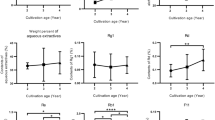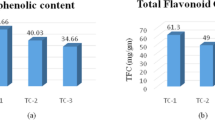Abstract
Artemisia argyi has been widely used as an herbal medicine and food in South Korea. However, the harvesting time of A. argyi is still not known. In addition, quality-based classification of A. argyi used for consumption is necessary because of its pharmacological properties. To this end, the A. argyi harvesting time was determined, and quality grading of A. argyi was performed based on the following factors: the contents of eupatilin, jaceosidin, essential oils and the leaf weight ratio. It is appropriate to harvest A. argyi at the end of June in 2019 and the plants harvested in early July exhibit the highest quality, considering weather condition and statistical analyses. To grade the quality of A. argyi, machine learning algorithms were applied based on the aforementioned four components. Among the various models, the logistic regression model showed the best performance, with an area under the receiver operating characteristic curve of 0.906. In this study, we developed methods for determining the harvest time and classifying its quality so that it can be applied to different weather conditions every year with precision.






Similar content being viewed by others
Data availability
Data are archived in S. Chung’s lab and available upon request.
References
Ahn JB, Hur JH, Jung GG, Park JH (2012) Study on the growth environment of ‘Ganghwa-mugwort’ through the climatological characteristic analysis of Ganghwa region. Korean J Agric for Meteorol 14:71–78
Ahn MS, Jie EY, Song SY, Kim HS, Kim IJ, Kim SW (2016) Simultaneous estimation of saponin contents from soybean seed using Fourier transform infrared spectroscopy and high-performance liquid chromatography analysis. Plant Biotechnol Rep 10:403–414. https://doi.org/10.1007/s11816-016-0411-x
Bang MH, Kim DH, Yoo JS, Lee DY, Song MC, Yang HJ, Jeong TS, Lee KT, Choi MS, Chung HG, Baek NI (2005) Development of biologically active compounds from edible plant sources XIV. Isolation and identification of flavonoids from the aerial parts of sajabalssuk (Artemisia herba). J Appl Biol Chem 48:418–420
Cho YH, Chiang MH (2001) Essential oil composition and antibacterial activity of Artemisia capillaris, Artemisia argyi and Artemisia princeps. J Korean Soc Int Agric 13:313–320
Choi BB, Lee HJ, Bang SK (2005) Studies on the volatile flavor components and biochemical characterizations of Artemisia princeps and A. argyi. Korean J Food Nutr 18:334–340
Dutta Gupta S, Ibaraki Y, Pattanayak AK (2013) Development of a digital image analysis method for real-time estimation of chlorophyll content in micropropagated potato plants. Plant Biotechnol Rep 7:91–97. https://doi.org/10.1007/s11816-012-0240-5
Jin YZ, Han SK, Row KH (2005) Extraction and purification of Eupatilin from Artemisia princeps Pampan. J Korean Chem Soc 49:196–200
Jung DY, Ha HK, Kim AN, Lee SM (2000) Cytotoxicity of SD-994 from Artemisia argyi against L1210 cells with concomitant induction of antioxidant enzymes. Yakhak Hoeji 44:213–233
Kim MJ, Han JM, Jin YY, Baek NI, Bang MH, Chung HG, Choi MS, Lee KT, Sok DE, Jeong TS (2008) In vitro antioxidant and anti-inflammatory activities of jaceosidin from Artemisia princeps Pampanini cv. Sajabal Arch Pharm Res 31:429–437. https://doi.org/10.1007/s12272-001-1175-8
Kim EJ, Choi JY, Yu MR, Kim MY, Lee SH, Lee BH (2012) Total polyphenols, total flavonoid contents, and antioxidant activity of Korean natural and medicinal plants. Korean J Food Sci Technol 44:337–342. https://doi.org/10.7841/ksbbj.2016.31.2.100
Kim SW, Ahn MS, Kwon YK, Song SY, Kim JK, Ha SH, Kim IJ, Liu JR (2015) Monthly metabolic changes and PLS prediction of carotenoid content of citrus fruit by combined Fourier transform infrared spectroscopy and quantitative HPLC analysis. Plant Biotechnol Rep 9:247–258. https://doi.org/10.1007/s11816-015-0361-8
Kwon MC, Kim CH, Kim HS, Lee SH, Chio GP, Park UY, You SG, Lee HY (2007) Optimal extract condition for the enhancement of anticancer activities of Artemisia princeps Pampanini. Korean J Medicinal Crop Sci 15:233–240
Kwon SH, Ku KB, Tomar V, Yildiz M, Kang SB, Park Y, Park WP, Han GD (2023) Case study: things to be considered for high-throughput phenotyping in genomic studies. Plant Biotechnol Rep 17:415–420. https://doi.org/10.1007/s11816-023-00834-9
Lee SD, Park HH, Kim DW, Bang BH (2000) Bioactive constituents and utilities of Artemisia sp. as medicinal herb and foodstuff. Korean J Food & Nutr 13:490–505
Min SW, Kim NJ, Baek NI, Kim DH (2009) Inhibitory effect of Eupatilin and jaceosidin isolated from Artemisia princeps on carrageenan-induced inflammation in mice. J Ethnopharmacol 125:497–500. https://doi.org/10.1016/j.jep.2009.06.001
Oh TY, Ahn BO, Ko JI, Ryu BK, Son MW, Kim SH, Kim WB, Lee EB (1997) Studies on protective effect of DA-9601, an Artemisiae herba extract, against ethanol-induced gastric mucosal damage and its mechanism. J Appl Pharm 5:202–210
Ryu SN (2008) Bioactive constituents and utilities of Ganghwayakssuk (Artemisia princeps Pamp.). J Korean Soc Int Agric 20:308–314
Ryu SN, Han SS, Yang JJ, Jeong HG, Kang SS (2005) Variation of Eupatilin and jaceosidin content of mugwort. Korean J Crop Sci 50:204–207
Shin DH, In JK, Yu JR, Choi KS (2005) Investigation of medicinal substances from in vitro cultured cells and leaves of Artemisia princeps var. Orientalis Korean J Medicinal Crop Sci 13:69–76
Trinh HT, Lee IA, Hyun YJ, Kim DH (2011) Artemisia princeps Pamp. essential oil and its constituents eucalyptol and α-terpineol ameliorate bacterial vaginosis and vulvovaginal candidiasis in mice by inhibiting bacterial growth and NF-κB activation. Planta Med 77:1996–2002. https://doi.org/10.1055/s-0031-1280094
Yoon KD, Chin YW, Yang MH, Kim JW (2011) Separation of anti-ulcer flavonoids from Artemisia extracts by high-speed countercurrent chromatography. Food Chem 129:679–683. https://doi.org/10.1016/j.foodchem.2011.05.005
Acknowledgements
This research received no specific grant from any funding agency.
Funding
This work was supported by a research grant (RS-2023-00259086) from RDA, Korea.
Author information
Authors and Affiliations
Corresponding author
Additional information
Publisher's Note
Springer Nature remains neutral with regard to jurisdictional claims in published maps and institutional affiliations.
Supplementary Information
Below is the link to the electronic supplementary material.
Supplementary file 1: Figure S1.
Weather conditions at the study site in 2019. Figure S2. Pairwise scatterplot matrices, density plots, and Pearson correlation coefficients of all variables. Figure S3. Diagnostic plots to evaluate several assumptions of regression model. Figure S4. Relative importance of predictor variables in the predictive linear model. Figure S5. Simulation-based histograms for estimating the coefficients of linear regression equation.
Rights and permissions
Springer Nature or its licensor (e.g. a society or other partner) holds exclusive rights to this article under a publishing agreement with the author(s) or other rightsholder(s); author self-archiving of the accepted manuscript version of this article is solely governed by the terms of such publishing agreement and applicable law.
About this article
Cite this article
Heo, S., Chung, S. Development of phenomic approaches to estimate harvesting time of Artemisia argyi and classifying its quality based on flavonoids, essential oil and leaf weight ratio. Plant Biotechnol Rep 17, 459–469 (2023). https://doi.org/10.1007/s11816-023-00846-5
Received:
Revised:
Accepted:
Published:
Issue Date:
DOI: https://doi.org/10.1007/s11816-023-00846-5




